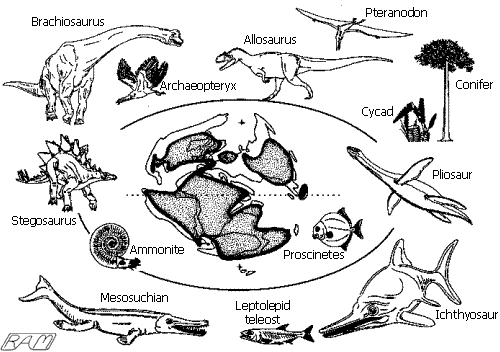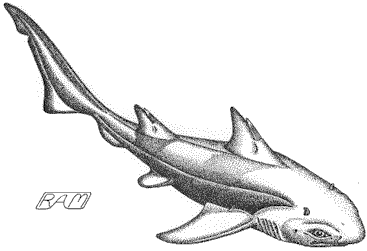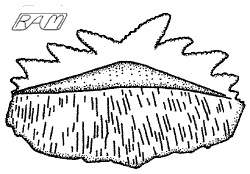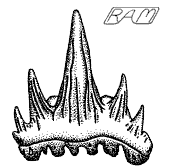The Origin of Modern Sharks
The second major radiation of sharks occurred during the Jurassic Period, 208 to 144 million years ago. At this time, pterosaurs ruled the skies and the first birds were taking to the air. On land, gigantic sauropod dinosaurs such as Brachiosaurus stripped leaves from the branches of tall trees like cycads and conifers. Stegosaurs dined on smaller plants, nervously watching for Allosaurus and other large carnivorous theropods. In the seas, ichthyosaurs, long-necked and short-necked plesiosaurs, and mesosuchian crocodilians pursued schools of bony fishes and flotillas of ammonites. It was into this Jurassic world that the modern sharks first appeared.

The Jurassic World
Hybodonts
No one is sure from which group of ancient sharks their modern descendants evolved. Until recently, it was thought that all modern sharks descended from a group known as the hybodonts.
Hybodus, which grew to a length of eight feet (2.5 metres) and lived in shallow seas about 180 million years ago, is perhaps the best known example of this group. (The hybodonts even had representatives in freshwater and brackish habitats. Most of these freshwater hybodonts were extremely small - such as the 6-inch [15-centimetre] Lissodus, known from Permian deposits in Africa about 275 million years old.) Hybodus was certainly very sharky-looking, with a blunt head, a curious ridge above the eyes, a well-developed spine on the forward edge of both dorsal fins, and two types of teeth: high grasping 'canines' in the front of the mouth, low crushing 'molars' in the rear.
 |
With its spined dorsal fins and bovine ridges above the eyes, the Jurassic shark Hybodus superficially resembles the bullhead sharks of today, but it also had some features not found in modern sharks - such as the devilish 'horns' behind the eyes. Re-drawn from an uncredited illustration in Sharks by Joyce Pope (Firefly Books, Willowdale 1997) |
It has even been suggested that Hybodus was a direct ancestor to the modern bullhead sharks (family Heterodontidae), which have somewhat similar brow ridges, fin spines and teeth. Paleoichthyologist John G. Maisey is probably the world's foremost authority on hybodonts. Based on his extensive studies of fossil and modern sharks, Maisey believes that the hybodonts were a side-branch of shark evolution that did not give rise to any group of modern shark. Maisey has proposed that a fossil genus known as Synechodus may be more closely related to modern sharks than the hybodonts. In the long run, this may mean that Synechodus and modern sharks are "sister groups" (sharing a relatively recent common ancestor) with the hybodonts sharing a more distant ancestor with both groups. Only time and further research can shed more light on the murky origins of modern sharks.
Mcmurdodus
The earliest known modern shark may be Mcmurdodus, which is known from mid-Devonian deposits (about 390 million years old) in what is now western Queensland, Australia. On first consideration, this is an astonishingly early date for the origin of modern sharks - actually predating Cladoselache and Antarctilamna. The modern shark status of Mcmurdodus is based on the structure of its tooth enameloid, which - although proper histological examination has not yet been carried out - appears to be of a multi-layered type which is found in all living sharks but not in most ancient sharks (a potentially important exception is Xenacanthus, which is still regarded as an ancient shark due to other structural features). If Mcmurdodus, Cladoselache, and Antarctilamna are members of lineages that appeared at about the same time, it is tempting to speculate that they are all results of a single massive shark radiation that occurred in the early Devonian. Although Cladoselache, Antarctilamna and other ancient shark lineages persisted for a while, only the modern sharks (whether descended from Mcmurdodus or not) made the final casting cut in the Great Evolutionary Drama.
|
This fossilized tooth of Mcmurdodus resembles the symmetrical tooth at the centre of the lower jaws of modern Broadnose Sevengill Sharks (Notorynchus). If histological study reveals that this tooth has a crown sheathed with multi-layered enamel, it would push the origin of modern sharks back to 390 million years ago. |
 |
How Mcmurdodus is related to living sharks is not clear. Like many of the earliest sharks, Mcmurdodus is known only from its fossilized teeth. In overall form, these resemble the sawlike lower teeth of the extant cowsharks (family Hexanchidae). This resemblance, however, may be due to convergence (the development in unrelated organisms of similar anatomical solutions to shared environmental challenges) rather than evolutionary relatedness. There is a 190-million-year gap in the fossil record between the last Mcmurdodus and the first unquestionable cowshark. This large gap does not preclude the possibility that Mcmurdodus was related to the modern cowsharks, but it does make it difficult to 'connect the dots' with any confidence.
Paleospinax
|
|
About 140 million years after Mcmurdodus, there appeared another early modern shark named Paleospinax. Paleospinax is known primarily from teeth of early Triassic to Eocene age, about 250 to 60 million years ago. However, a few specimens from early Jurassic deposits in what is now England and Germany include well-preserved impressions of jaws and vertebrae. Paleospinax was less than three feet (1 metre) long and had many of the features associated with modern sharks, including: a longish snout, a mouth located underneath the head (a mouth type termed "subterminal"), short jaws that were attached to the cranium only at the back, teeth with dense enameloid, and well-developed vertebrae. In its overall body form and the presence of fin spines, Paleospinax resembled the modern spiny dogfishes (family Squalidae) - although some paleoichthyologists have suggested that it may have been a galeomorph, a group which includes many of the most familiar non-dogfish sharks. Despite their antiquity and uncertainties as to how they are related to living sharks, both Mcmurdodus and Paleospinax are among the earliest modern sharks, belonging to a group known as the neoselachians ("new sharks").
Rise of the Neoselachians
The neoselachians radiated rapidly and by the mid-Cretaceous, about 100 million years ago, most modern groups of sharks had appeared. In a 1985 paper, paleontologists Detlev Thies and Wolf-Ernst Reif proposed that the neoselachian radiation was an opportunistic response to abundant new sources of food. Thies and Reif deemed the radiation of two types of bony fishes particularly important in fueling the flowering of new sharks: the ray finned fishes (class Actinopterygii) - especially the carp-shaped semionotids and other basal neopterygians - in the late Triassic, and the so-called 'higher' teleosts (a phylogenetic hodgepodge containing most of the better known ray finned fishes) from the early Jurassic onward. These new bony fish types provided vast shoals of fast swimming, thin scaled food-on-the-fin for those predators that could catch them. The neoselachians answered this 'dinner call' admirably - they had the speed, maneuverability, flexible jaws, and enhanced sensory systems essential to hunting such swift prey.
The early neoselachians were predominately near-shore predators. But in the mid-Cretaceous, neoselachians evolved a whole new mode of making a living: fast offshore hunting. Thies and Reif suggested that this new hunting mode was in response to increased size and speed of teleost fishes and pelagic squids. These fast off-shore neoselachians did not, however, rule their pelagic realm uncontested. The marine reptiles of that time - such as the dolphin-shaped ichthyosaurs and the long-necked, rhomboid-paddled plesiosaurs - may have been fast enough to compete with these neoselachian upstarts, and perhaps even eat the smaller species. In contrast, the late Cretaceous mosasaurs - huge, short-necked, crocodile-like relatives of the plesiosaurs - were probably too slow and lumbering to compete with the faster, more agile offshore sharks and may have been preyed upon by the very largest species.
At the end of the Cretaceous, about 65 million years ago, a global catastrophe wiped out the last of the hybodonts, the Mesozoic sea-dragons, Tyrannosaurus, Triceratops and the rest of the dinosaur dynasty. But, once again, the sharks survived. The new (and improved) sharks we see today are thus survivors from the age of dinosaurs.

